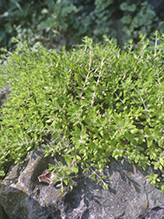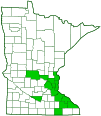stringy stonecrop
(Sedum sarmentosum)
Conservation • Description • Habitat • Ecology • Use • Distribution • Taxonomy
Conservation Status |
|
|||||||
| IUCN Red List | not listed |
|||||||
| NatureServe | NNA - Not applicable |
|||||||
| Minnesota | not listed |
|||||||
Description |
||
Stringy stonecrop is an exotic, evergreen, succulent, flowering plant. It is native to China, Korea, and Thailand. It was introduced, cultivated as an ornamental ground cover, escaped cultivation, and is now naturalized in eastern North America and in central and eastern Europe. It now occurs throughout the eastern half of the United States. It is uncommon in Minnesota, which is at the western extent of its spread. It is found in open woodlands, banks of streams and rivers, parks, cemeteries, roadsides, and disturbed areas. It grows under full sun to light shade in moderately moist to dry areas on loamy or rocky, calcareous or acidic soil. It is drought tolerant and often forms loose mats. Stringy stonecrop is perennial forb that rises from fibrous roots. Non-flowering (vegetative) stems are fleshy, branched, round in cross section, and 2″ to 12″ (5 to 30 cm) long. They are light green to white and hairless. They do not have a whitish, waxy coating (glaucous), and they are rarely tinged reddish or pinkish. They may lie flat on the ground (prostrate) or curve upward from the base (ascending). Where a node contacts the ground the stem produces roots. It may separate at this point creating a vegetative offset, a new plant. Flowering stems are 2″ to 8″ (5 to 20 cm) long. They are unbranched, prostrate or ascending, and usually tinged reddish. They do not root at the nodes. The leaves are mostly in well-spaced whorls of 3, sometimes opposite, and spread outward from the stem. They are stalkless and are attached slightly above the base, producing a pair of minute, pouch-like spurs below the attachment point. They are thick and succulent but flat in cross section, ⅜″ to 1 3⁄16″ (10 to 30 mm) long, and ⅛″ to ¼″ (4 to 6 mm) wide. They gradually and only slightly reduce in size as they ascend the stem. The blades are narrowly oval and sharply pointed at the tip. They may be widest toward the tip (obovate), widest in the middle (elliptic), or straight-sided (linear). The upper and lower surfaces are hairless. They are not glaucous. The margins are untoothed. The inflorescence is a 2- or 3-branched cluster (panicle) at the end of flowering stems. Each branch of the panicle terminates in a short, loosely ascending, somewhat zigzagged spike of a few flowers. Each flower is about ½″ wide. There are 5 outer floral leaves (sepals), 5 petals, 10 stamens, and 5 carpels, each with a single style. The sepals are green, fleshy, spreading, ⅛″ to 3 ⁄16″ (3.5 to 5 mm) long, narrowly oblong lance-shaped, and bluntly pointed at the tip. Like the leaves, they have a pair of minute, pouch-like spurs at the base. The petals are yellow, 3 ⁄16″ to 5⁄16″ (5 to 8 mm) long, narrowly lance-shaped, and sharply pointed. The stamens have yellow stalks (filaments) and yellow anthers. The filaments are attached at the bases of the petals. The carpels are greenish-yellow. The fruit is a brown, ⅛″ to ¼″ (4.5 to 6 mm) long seed capsule (follicle) with many seeds. The fruits usually wither before reaching maturity and the seeds abort during development. With few viable fruits, it usually does not escape over long distances. |
||
Height |
||
Matting: 2″ to 11¾″ (5 to 30 cm) long |
||
Flower Color |
||
Yellow |
||
Similar Species |
||
Goldmoss stonecrop (Sedum acre ssp. acre) has much shorter stems and much smaller leaves. The leaves are alternate, crowded, overlapping, and egg-shaped. |
||
Habitat |
||
Moderately moist to dry. Open woodlands, banks of streams and rivers, parks, cemeteries, roadsides, and disturbed areas. Full sun to light shade. Loamy or rocky, calcareous or acidic soil. |
||
Ecology |
||
Flowering |
||
Spring |
||
Pests and Diseases |
||
|
||
Use |
||
|
||
Distribution |
||||
|
Sources |
|||
| 7/17/2023 | ||||
Nativity |
||||
Native to China, Korea, and Thailand. Introduced, cultivated, and naturalized. |
||||
Occurrence |
||||
Uncommon outside of cultivation in Minnesota |
||||
Taxonomy |
|||
| Kingdom | Plantae (green algae and land plants) | ||
| Subkingdom | Viridiplantae (green plants) | ||
| Infrakingdom | Streptophyta (land plants and green algae) | ||
| Superdivision | Embryophyta (land plants) | ||
| Division | Tracheophyta (vascular plants) | ||
| Subdivision | Spermatophytina (seed plants) | ||
| Class | Magnoliopsida (flowering plants) | ||
| Superorder | Saxifraganae | ||
Order |
Saxifragales (saxifrages, stonecrops, and allies) | ||
Family |
Crassulaceae (stonecrop) | ||
| Subfamily | Sempervivoideae | ||
| Tribe | Sedeae | ||
| Subtribe | Sedinae | ||
| Genus | Sedum (stonecrops) | ||
Synonyms |
|||
|
|||
Common Names |
|||
graveyard moss stringy stonecrop |
|||
Glossary
Ascending
Growing upward at an angle or curving upward from the base.
Carpel
The female reproductive organ of a flower, consisting of an ovary, styles, and stigmas.
Elliptic
Narrowly oval, broadest at the middle, narrower at both ends, with the ends being equal.
Filament
On plants: The thread-like stalk of a stamen which supports the anther. On Lepidoptera: One of a pair of long, thin, fleshy extensions extending from the thorax, and sometimes also from the abdomen, of a caterpillar.
Follicle
A dry fruit formed from a single carpel, containing many seeds, that opens at maturity along the seed-bearing seam.
Glaucous
Pale green or bluish gray due to a whitish, powdery or waxy film, as on a plum or a grape.
Linear
Long, straight, and narrow, with more or less parallel sides, like a blade of grass.
Oblong
Two to four times longer than wide with nearly parallel sides.
Panicle
A pyramidal inflorescence with a main stem and branches. Flowers on the lower, longer branches mature earlier than those on the shorter, upper ones.
Prostrate
Laying flat on the ground.
Sepal
An outer floral leaf, usually green but sometimes colored, at the base of a flower.
Spreading
Extending nearly horizontal.
Visitor Photos |
|||||
Share your photo of this plant. |
|||||
| This button not working for you? Simply email us at info@MinnesotaSeasons.com. Attach one or more photos and, if you like, a caption. |
|||||
Ashley Slowinski |
|||||
 |
|||||
MinnesotaSeasons.com Photos |
|||||
|
|||||

Slideshows |
||

Visitor Videos |
|||
Share your video of this plant. |
|||
| This button not working for you? Simply email us at info@MinnesotaSeasons.com. Attach a video, a YouTube link, or a cloud storage link. |
|||
Other Videos |
|||
| Propagating and Transplanting Sedum Sarmentosum! This Stuff Grows SO FAST! Wisconsin Wonder Garden |
|||
About
Jun 16, 2017 I wanted to take a little time out of my day to show you guys a little bit about the sedum sarmentosum that I have growing out back in several areas! This is a wonderful ground cover that will grow and spread quickly for you and also puts on a beautiful bright yellow flower :) Propagating this plant is very easy as it will root very readily and has no problem adjusting to all kinds of soil conditions. Please Feel Free To Shop Amazon For All Of Your Gardening Needs To Help Support This Channel Through Our Affiliate Link! Thank you so much for watching! If you have any questions or even a suggestion for an upcoming video please comment below! Have a GREAT day. Buy Wisconsin Wonder Garden merchandise |
|||
| Garden Story - bees and Sedum sarmentosum FacingWestPatio |
|||
About
May 26, 2019 Lots of bees foraging on flowers of Sedum sarmentosum also known as stringy stonecrop, gold moss stonecrop, and graveyard moss. |
|||
| Sedum Sarmentosum - Graveyard Moss - Is It a Garden Thug? Kim's Gardens |
|||
About
Jun 23, 2017 https://www.thehypertufagardener.com/sedum-sarmentosum/ If you want a fast-growing sedum, then this Sedum sarmentosum is the one. First of all, when you see fast-growing describing any plant, use a little bit of caution because that could mean you could be bringing in a runaway Garden Thug into your garden too! However, if you need a plant which comes back year after year in a place where you find it hard to grow anything, this would be it. Read more about gardening with succulents and making hypertufa pots for them on my blog. My email is: kimann@woh.rr.com Check out my website: http://www.thehypertufagardener.com Facebook: The Hypertufa Gardener Group https://www.facebook.com/groups/TheHypertufaGardenerGroup/ Video by: TheHypertufaGardener All Rights Reserved and protected against unauthorized use. |
|||

Created: 9/5/2020
Last Updated:


